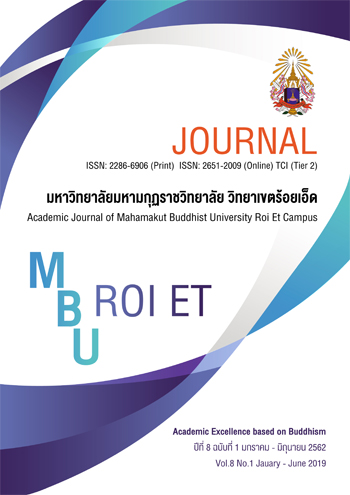Development of Teaching Sets Basing on Guidelines on STEM Education Integrated with the 7 Learning Steps of the Learning Cycle (7E) on the Topic of Polymer for Mathayom Suksa 4 Students
Main Article Content
Abstract
The research aimed to : (1) develop teaching sets basing on guidelines on STEM education integrated with the 7 learning steps of the Learning Cycle (7E) on the topic of Polymer for Mathayom Suksa 4 Students to meet the 80/80 efficiency criterion; (2) study the effectiveness index of the teaching sets basing on guidelines on STEM education integrated with the 7 learning steps of the Learning Cycle (7E) on the topic of Polymer for Mathayom Suksa 4 Students; (3) compare the learning achievements before and after learning using the teaching sets basing on guidelines on STEM education integrated with the 7 learning steps of the Learning Cycle (7E) on the topic of Polymer for Mathayom Suksa 4 Students; (4) study the analytical thinking ability of Mathayom Suksa 4 Students before and after learning using the teaching sets basing on guidelines on STEM education integrated with the 7 learning steps of the Learning Cycle (7E) on the topic of Polymer for Mathayom Suksa 4 Students; (5) study the students’ satisfaction with learning using the teaching sets basing on guidelines on STEM education integrated with the 7 learning steps of the Learning Cycle (7E) on the topic of Polymer. The sample comprised 32 Mathayom Suksa 4/1 Students of Suakokwittayasan School, Mahasarakham Provincial Administrative Organization in the 1st semester of the academic year 2017, obtained through cluster random sampling, using the learning group as the sampling unit. The research instruments consisted of (1) 5 teaching sets basing on guidelines on STEM education integrated with the 7 learning steps of the Learning Cycle (7E) on the topic of Polymer, for 15 hours; (2) a 4-choice learning achievement test on Polymer containing 30 questions with the difficulty (P) of 0.38 - 0.69, the discrimination (B) of 0.44 - 0.71 and the total reliability of 0.85 ; (3) a 4-choice form to measure analytical thinking ability containing 30 questions with the difficulty of 0.32 - 0.75, the discrimination of 0.25 - 0.67 and the total reliability of 0.83 ; and (4) a students’ satisfaction questionnaire containing 20 questions with the discrimination of 0.41 - 0.68 and the total reliability of 0.85. The statistics employed in the research were percentage, the mean, standard deviation and t-test (dependent samples) for hypothesis testing.
The results are as follows: (1)The efficiency of each teaching set basing on guidelines on STEM education integrated with the 7 learning steps of the Learning Cycle (7E) on the topic of Polymer for Mathayom Suksa 4 Students, which could meet the 80/80 efficiency criterion. (2)The effectiveness index of the teaching sets basing on guidelines on STEM education integrated with the 7 learning steps of the Learning Cycle (7E) on the topic of Polymer for Mathayom Suksa 4 Students was 0.6919 which indicates that the teaching sets basing on guidelines on STEM education integrated with the 7 learning steps of the Learning Cycle (7E) on the topic of Polymer increased the students’ knowledge at 0.6919 or 69.19 percent. (3)The comparison of the Mathayom Suksa 4 Students’ learning achievements revealed that the average posttest score was higher than the average pretest score, with statistical significance at the .05 level. (4)The comparison of the Mathayom Suksa 4 Students’ average scores of analytical thinking revealed that the average posttest score was higher than the average pretest score, with statistical significance at the .05 level. (5) The grade 10 students’ overall satisfaction with learning using the teaching sets basing on guidelines on STEM education integrated with the 7 learning steps of the Learning Cycle (7E) on the topic of Polymer was at a high level. When considered item by item, the 3 items with the highest average scores, ranked in descending order, are: the item with the highest score -instruction on using the teaching set was clear, easy to understand and convenient to be used by students independently; -the item with the score second to highest –the students had the ability to conclude relationships of the data correctly; and –learning with the teaching sets helped widen the students’ experiences and they can be applied in daily life.
In summary, the development of the teaching sets basing on guidelines on STEM education integrated with the 7 learning steps of the Learning Cycle (7E) on the topic of Polymer for Mathayom Suksa 4 Students which had been constructed and developed had suitable efficiency which can be used in organizing learning activities with quality. They helped the students in the group to help each other doing their work and creating good relationship in the group. All these resulted in higher learning achievements and students’ satisfaction at a high level.
Article Details
References
กระทรวงศึกษาธิการ. (2551). หลักสูตรแกนกลางการศึกษาขั้นพื้นฐาน. กรุงเทพมหานคร : โรงพิมพ์คุรุสภาลาดพร้าว.
ทิศนา แขมมณี. (2551). ลีลาการเรียนรู้-ลีลาการสอน. กรุงเทพมหานคร : จุฬาลงกรณ์มหาวิทยาลัย.
นงนุช เอกตระกูล. (2557). การพัฒนาการจัดการเรียนรู้แบบ STEM เพื่อเพิ่มผลสัมฤทธิ์ทางการเรียนและความสามารถในการคิดแก้ปัญหาอย่างสร้างสรรค์ (CPS) ของนักเรียนชั้นมัธยมศึกษาปีที่ 6. สืบค้นเมื่อ 11 กุมภาพันธ์ 2560. จาก http://swis.act.ac.th /html_edu/act/temp_emp_research/2605.pdf
บุษราคัม บุญกลาง. (2557). การเปรียบเทียบผลสัมฤทธิ์ทางการเรียนและเจตคติต่อการเรียนวิชาวิทยาศาสตร์ของ นักเรียน ชั้นมัธยมศึกษาปีที่ 5 ระหว่างการจัดการเรียนรู้แบบวัฏจักรการเรียนรู้ 7 ขั้น กับการจัดกิจกรรมการเรียนรู้แบบปัญหาเป็นฐาน. วิทยานิพนธ์ การศึกษามหาบัณฑิต (หลักสูตรและการสอน). มหาสารคาม : มหาวิทยาลัยมหาสารคาม.
ฝ่ายวิชาการ โรงเรียนเสือโก้กวิทยาสรรค์. (2559). รายงานผลสัมฤทธิ์ทางการเรียนประจำปีการศึกษา 2559. มหาสารคาม : ฝ่ายวิชาการ โรงเรียนเสือโก้กวิทยาสรรค์.
พิมพ์ลภัส อุ่นทรัพย์. (2554). การพัฒนาชุดการเรียนรู้ เรื่องกรด-เบส กลุ่มสาระการเรียนรู้วิทยาศาสตร์ สาหรับนักเรียนชั้นมัธยมศึกษาปีที่ 5. วิทยานิพนธ์ครุศาสตรมหาบัณฑิต. มหาวิทยาลัยราชภัฏเทพสตรี.
รัตน์ดาวัล วรรณปะเถาว์. (2560). การพัฒนาผลสัมฤทธิ์ทางการเรียน ทักษะกระบวนการทางวิทยาศาสตร์ขั้นบูรณาการของนักเรียนชั้นมัธยมศึกษาปีที่ 2 โดยการจัดการเรียนการสอนตามแนวทางสะเต็มศึกษา. วิทยานิพนธ์การศึกษามหาบัณฑิต. มหาสารคาม : มหาวิทยาลัยมหาสารคาม.
รุ่งทิวา การะกุล. (2559). การพัฒนาชุดกิจกรรมการเรียนรู้วิทยาศาสตร์ ตามแนวทฤษฎีคอนสตรัคติวิสต์ ชั้นมัธยมศึกษาปีที่ 4. วิทยานิพนธ์การศึกษามหาบัณฑิต. มหาสารคาม :มหาวิทยาลัยมหาสารคาม.
สุปาณี วังกานนท์. (2558). การพัฒนาชุดกิจกรรมการเรียนรู้วิทยาศาสตร์เพื่อแก้ปัญหาการคิดวิเคราะห์ตามหลักการของ Marzano สำหรับนักเรียนชั้นมัธยมศึกษาปีที่ 2. วิทยานิพนธ์การศึกษามหาบัณฑิต. มหาสารคาม : มหาวิทยาลัยมหาสารคาม.
สุพรรณี ชาญประเสริฐ. (2557). สะเต็มศึกษากับการจัดการเรียนรู้ในศตวรรษที่ 21. นิตยสาร สสวท. 42(18). 3-5.

